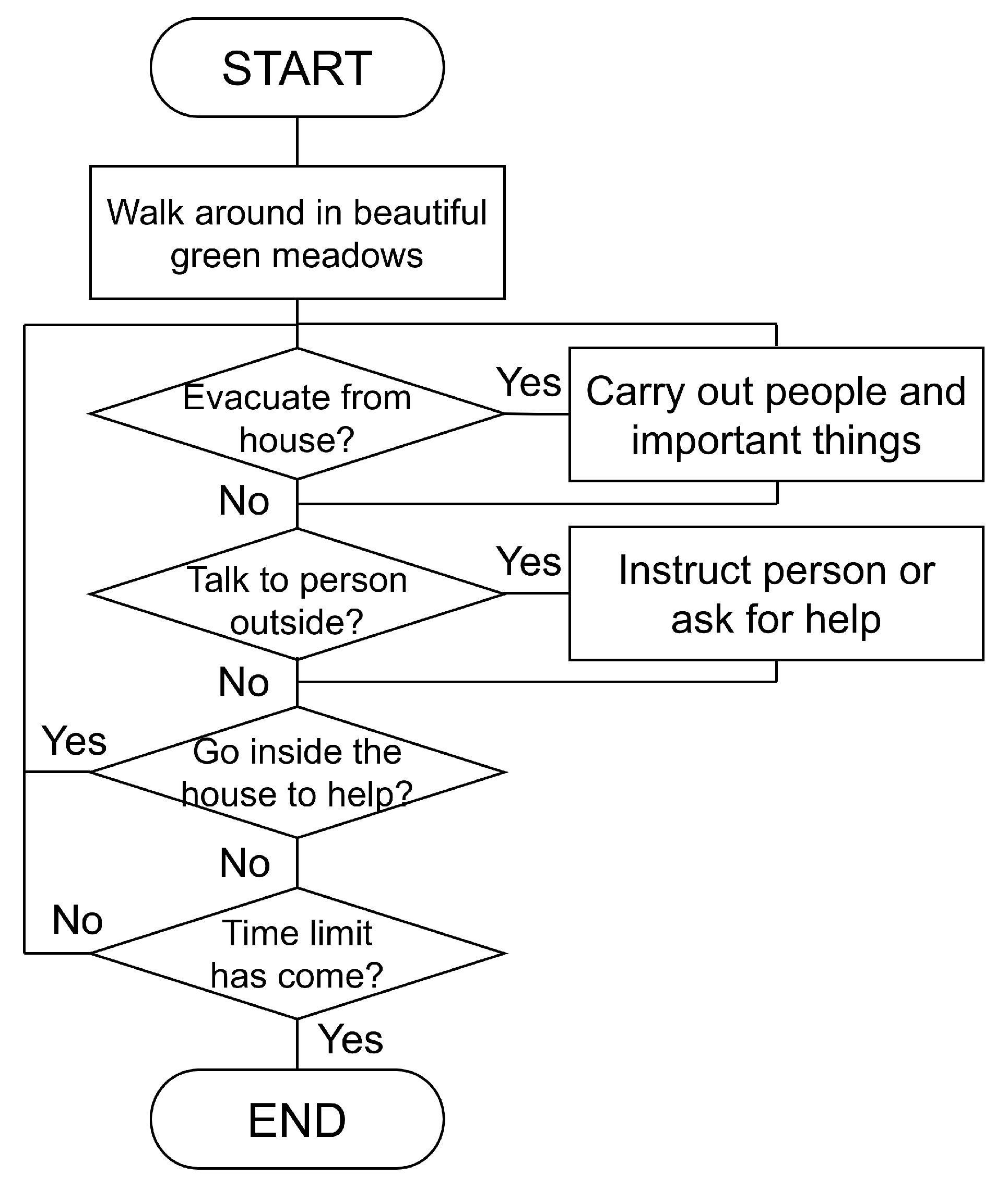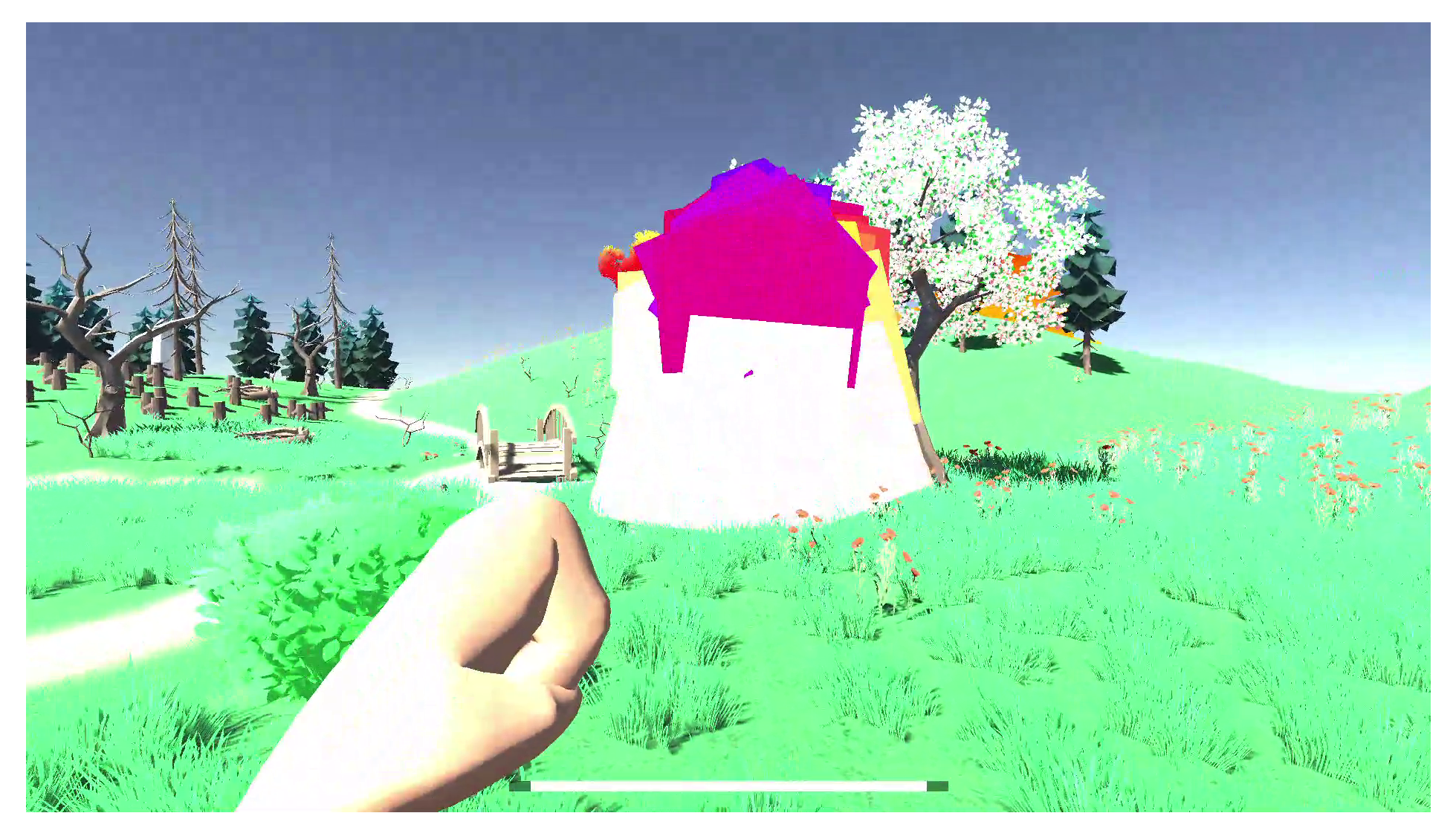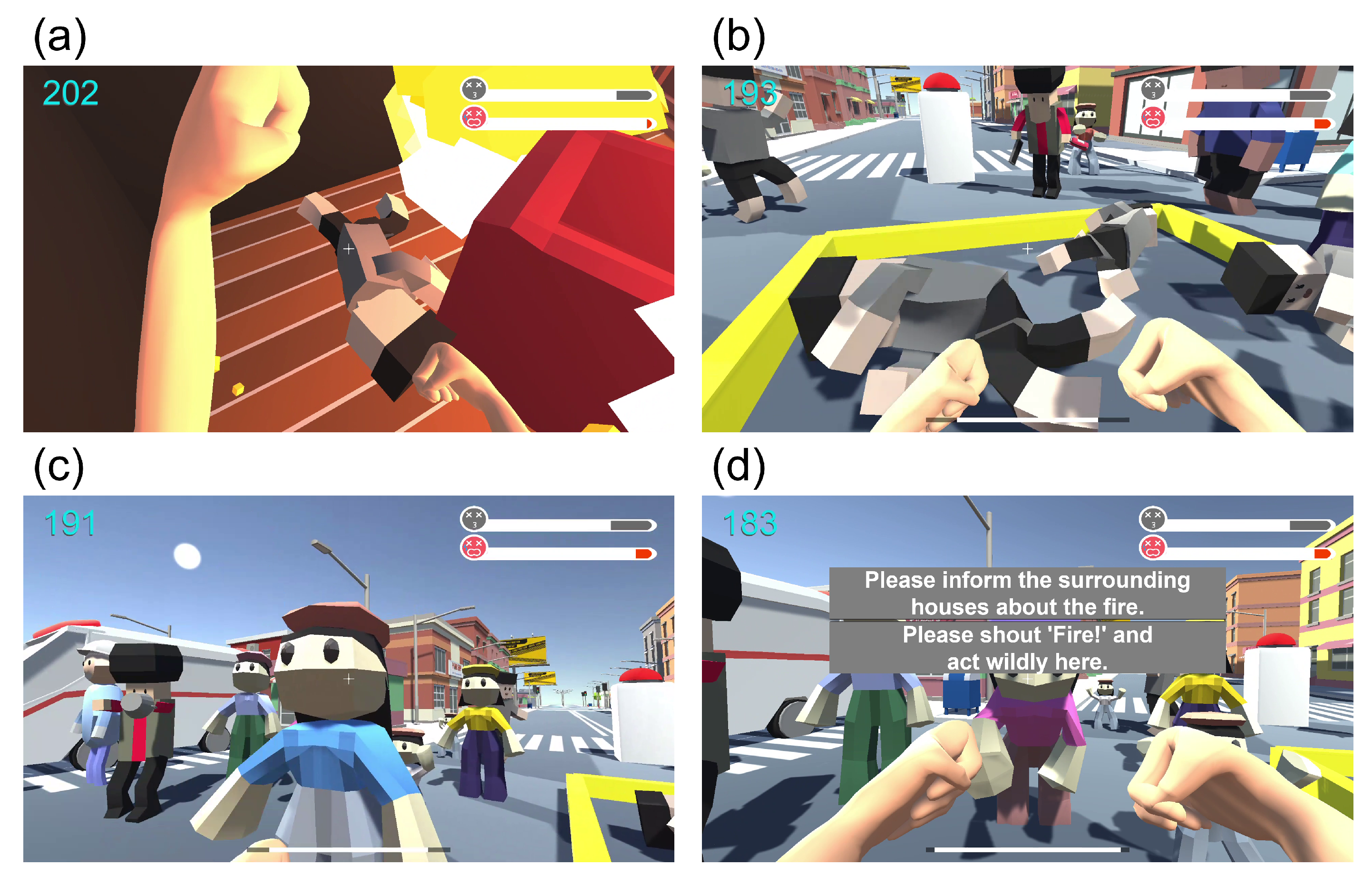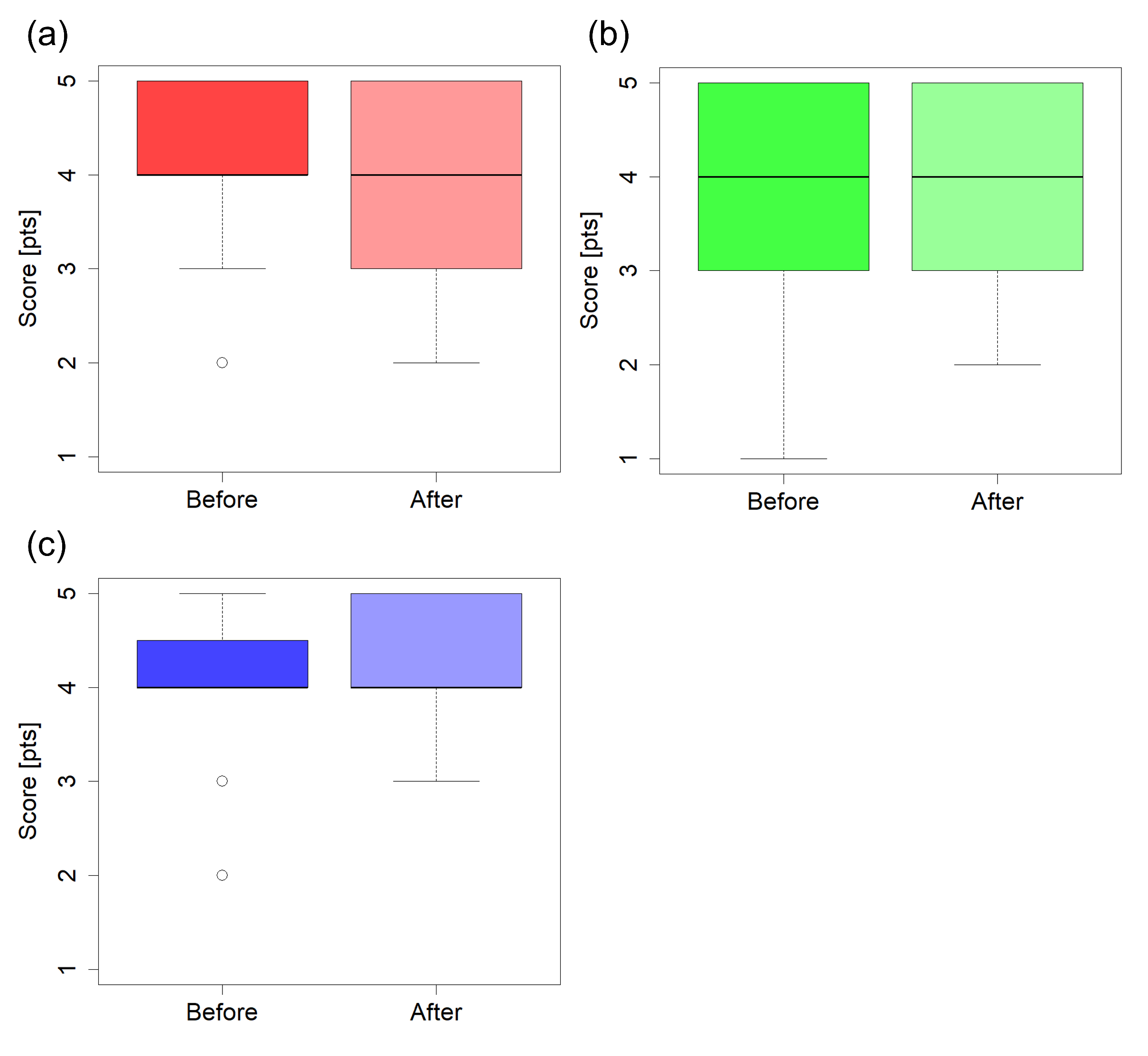Development and Evaluation of a Game to Foster Sustainable Self-Help and Mutual Help Education for Disaster Prevention
Abstract
1. Introduction
- The development of a game for increasing the awareness of self-help and mutual aid during a disaster.
- Evaluation of the effect of a game and whether awareness of self-help and mutual aid increased.
2. Design and Development of the Game
2.1. Design of the Game
2.1.1. Tools Used for Development
2.1.2. Concept of the Game
- The player must rescue an injured person outside.
- The player must successfully evacuate people who are panicking outdoors.
- In addition to helping others, the player must also evacuate themselves quickly.
2.2. Development of the Game
2.2.1. Purpose of the Game
2.2.2. Stage Configuration
2.2.3. Elements to Improve Realism of the Game
- (1)
- “Fire” and “smoke” gauges:In an actual fire scene, it is crucial to pay attention to fire and smoke. Individuals must avoid exposure to flames and smoke. Therefore, two kinds of gauges were displayed at the top right of the screen: “fire” and “smoke” gauges. Both gauges increase gradually when the player remains in the house. Additionally, these gauges increase rapidly if the player touches the fire and smoke. Therefore, the player must navigate the environment without coming into contact with flames or smoke, particularly by crouching to minimize exposure. The game concludes when either of the gauges reaches its maximum capacity. Figure 4 shows the “fire” and “smoke” gauges.
- (2)
- Scoring system:To enhance the gameplay from the point of gamification, the player receives a score if they behave or direct others correctly. Table 1 details the actions that contribute to earning points. As shown in Table 1, actions directly related to saving people’s lives yield more points. In addition, players are also required to successfully evacuate themselves. In this study, we did not analyze the score of each participant.
- (3)
- Choice of behavior:As shown in Figure 3a,b, the player can rescue people by carrying them out of the fire scene. However, when the player chooses to carry a person, the game’s pace slows down, and the smoke is inhaled, thus leaving the decision to rescue the victim up to the player’s discretion.
- (4)
- Set time limit:A time limit is set, and points are awarded for rescues completed within this timeframe. In this game, the limit was set to 300 s from the start. Once this period expires, the game is over. Therefore, players must execute rescues and make decisions promptly. The remaining time is displayed in the upper left corner of the screen, as shown in Figure 4.
3. Experiment
3.1. Participants
3.2. Experimental Procedure
3.3. Data Extraction and Analysis
- Q1
- Were you able to cooperate with strangers?
- Q2
- Did you give the right instructions?
- Q3
- Are you conscious of helping others?
4. Results and Considerations
4.1. Results of the Questionnaire
4.1.1. Cooperation with Strangers
4.1.2. Giving the Right Instructions
4.1.3. Consciousness of Helping Others
4.2. Free Responses
- It was difficult to operate.
- It was really great!! The scenario of disasters, such as poor visibility, felt very realistic and well done.
- It was fun.
- It was interesting!
- The game had a lot to teach, and it was fun, but it was difficult because I’m not used to using a PC. I hope there is a smartphone version!
- The details like crouching to avoid smoke and vending machines having addresses were nice touches. Brilliant!
- Amazing!
- It was really interesting.
- There were times when I did not know what to do, so the tutorial could use some improvements.
- I scored 60,000 points! I will play again.
- As someone without game development knowledge, I felt this was really well made. At this level of quality, it would not be out of place on Steam.
- Lifting people was difficult.
- I want to become a firefighter!
- I genuinely think it is amazing that you can create such a game. I would be honored to help in any way I can. Keep up the good work!
- Make the color scheme easier to understand.
5. Discussion
6. Conclusions
Author Contributions
Funding
Institutional Review Board Statement
Data Availability Statement
Conflicts of Interest
References
- Kawada, Y. Prediction of Loss of Human Lives Due to Catastrophic Earthquake Disaster. J. Jpn. Soc. Nat. Disaster Sci. 1997, 16, 3–13. (In Japanese) [Google Scholar]
- Morisaki, Y.; Fujiu, M.; Takayama, J.; Yanagihara, K.; Nishino, T.; Sagae, M.; Hirako, K. Basic abalysis of the regional mutual assistance potential during large scale earthquake disaster using KDB database in Hakui city. J. Jpn. Soc. Civ. Eng. Ser. A1 2018, 74, I_630–I_640. (In Japanese) [Google Scholar]
- Tokyo Metropolitan Park Association. Self Help, Mutual Aid. 2024. Available online: https://www.tokyo-park.or.jp/special/bousai/english/sonae.html (accessed on 19 July 2024).
- Matsuno, Y.; Fukanuma, F.; Tsuruoka, S. Development of Flood Disaster Prevention Simulation Smartphone Application Using Gamification. In Dynamics of Disasters; Kotsireas, I.S., Nagurney, A., Pardalos, P.M., Tsokas, A., Eds.; Springer: Cham, Switzerland, 2020; pp. 147–159. [Google Scholar]
- Arakawa, T.; Obayashi, F.; Kobayashi, K.; Itamiya, T.; Uno, S.; Yamabe, S.; Suzuki, T. New Tsunami Evacuation Training Methods: A Tsunami Evacuation Training Application. Geosciences 2024, 14, 110. [Google Scholar] [CrossRef]
- Wahyuningtyas, N.; Ruja, I.N.; Yahya, M.H.; Wijaya, D.N.; Ibrahim, M.H. Developing of a Learning Media for Smartphones for Disaster Mitigation Education. Int. J. Emerg. Technol. Learn. 2021, 16, 160–174. [Google Scholar] [CrossRef]
- Anta, V.L.P.; Liestyo, I.A.; Warnars, H.L.H.S. Mobile Application for flood disaster in Jakarta. In Proceedings of the 2021 International Conference on Artificial Intelligence and Smart Systems (ICAIS), TamilNadu, India, 25–27 March 2021; pp. 506–510. [Google Scholar]
- Itamiya, T. VR/AR and Its Application to Disaster Risk Reduction. In Emerging Technologies for Disaster Resilience; Sakurai, M., Shaw, R., Eds.; Springer: Singapore, 2021; pp. 63–79. [Google Scholar]
- Tanaka, M. Day-camp for university students, staff, and residents to experience a simulated disaster together—Disaster education in university campus. Res. Educ. Pract. Dev. Gunma Univ. 2023, 40, 121–129. (In Japanese) [Google Scholar]
- Matsuo, Y.; Hirano, M. Effectiveness of disaster preparedness education in helping older people prevent isolation. Public Health Nurs. 2021, 38, 837–849. (In Japanese) [Google Scholar] [CrossRef] [PubMed]
- Chien, S.C.; Islam, M.M.; Yeh, C.A.; Chien, P.H.; Chen, C.Y.; Chin, Y.P.; Lin, M.C. Mutual-aid mobile app for emergency care: Feasibility study. JMIR Form. Res. 2020, 4, e15494. [Google Scholar] [CrossRef] [PubMed]
- Mayer, R.E. Cognitive theory of multimedia learning. In The Cambridge Handbook of Multimedia Learning, 2nd ed.; Mayer, R.E., Ed.; Cambridge University Press: Cambridge, UK, 2014; pp. 43–71. [Google Scholar]
- Otsuki, S.; Hoshino, O.; Shirotsuki, M.; Mizuta, T.; Kanegae, H. A study of development and evaluation of disaster mitigation gamming to promote awareness for community based disaster mitigation. J. Mitig. Hist. Cities 2008, 2, 77–84. (In Japanese) [Google Scholar]
- Kapp, K.M. The Gamification of Learning and Instruction: Game-Based Methods and Strategies for Training and Education; John Wiley & Sons: Hoboken, NY, USA, 2012. [Google Scholar]
- Kiryakova, G.; Angelova, N.; Yordanova, L. Gamification in education. In Proceedings of the 9th International Balkan Education and Science Conference, Edim, Turkey, 16–18 October 2014. [Google Scholar]
- Cabinet Office, Government of Japan. “Crossroad”, a Disaster Response Card Game Resource. 2024. Available online: https://www.bousai.go.jp/kyoiku/keigen/torikumi/kth19005.html (accessed on 20 July 2024). (In Japanese).
- United Nations Office for Disaster Risk Reduction. Play and Learn to Stop Disasters. 2024. Available online: https://www.stopdisastersgame.org/ (accessed on 20 July 2024).
- Board Game Fudakomahiroba. Original Board Game to Learn about Disaster Prevention. 2024. Available online: https://fudakoma.com/ (accessed on 20 July 2024). (In Japanese).
- Deterding, S.; Dixon, D.; Khaled, R.; Nacke, L. From game design elements to gamefulness: Defining “gamification”. In Proceedings of the 15th International Academic MindTrek Conference: Envisioning Future Media Environments, Tampere, Finland, 28–30 September 2011; pp. 9–15. [Google Scholar]
- Bandura, A. Social Learning Theory; Prentice Hall: Englewood Cliffs, NJ, USA, 1977. [Google Scholar]
- Bandura, A. Self-Efficacy: The Exercise of Control; Freeman: New York, NY, USA, 1977. [Google Scholar]
- Cabinet Office, Goverenment of Japan. Meaning of Aging and Declining Population. 2024. Available online: https://www5.cao.go.jp/zenbun/wp-e/wp-je03/03-00301.html (accessed on 20 July 2024).
- Nguyen, M.H.; Gruber, J.; Marler, W.; Hunsaker, A.; Fuchs, J.; Hargittai, E. Staying connected while physically apart: Digital communication when face-to-face interactions are limited. New Media Soc. 2022, 24, 2046–2067. [Google Scholar] [CrossRef]
- Ogane, M.; Umemoto, M.; Saito, A.; Itoigawa, E. Study on the Promotion of the Working Generation’s Participation in Voluntary Disaster Prevention Activities: Based on the Questionnaire in Tokai-mura. J. Soc. Saf. Sci. 2016, 29, 197–205. (In Japanese) [Google Scholar]
- Unity Technologies. Unity. 2024. Available online: https://unity.com/ (accessed on 3 May 2024).
- Collins, K. Game Sound: An Introduction to the History, Theory, and Practice of Video Game Music and Sound Design; MIT Press: Cambridge, MA, USA, 2008. [Google Scholar]
- Gentile, D.A.; Anderson, C.A.; Yukawa, S.; Ihori, N.; Saleem, M.; Lim, K.M.; Shibuya, A.; Liau, A.K.; Khoo, A.; Bushman, B.J.; et al. The effects of prosocial video games on prosocial behaviors: International evidence from correlational, longitudinal, and experimental studies. Pers. Soc. Psychol. Bull. 2009, 35, 752–763. [Google Scholar] [CrossRef] [PubMed]
- Dowling, Z. More than LOI: Understanding Response Burden. 2020. Available online: https://www.zoedowling.com/post/more-than-loi-understanding-response-burden (accessed on 5 September 2024).
- Jillson, I.A.; Clarke, M.; Allen, C.; Waller, S.; Koehlmoos, T.; Mumford, W.; Jansen, J.; McKay, K.; Trant, A. Improving the science and evidence base of disaster response: A policy research study. BMC Health Serv. Res. 2019, 19, 274. [Google Scholar] [CrossRef] [PubMed]
- PR TIMES. The Ability to Help Each Other in Times of Disaster Is the Key! What Is Your “Mutual Help Score”? 2021. Available online: https://prtimes.jp/main/html/rd/p/000001204.000011414.html (accessed on 12 July 2024). (In Japanese).
- SmileBoom Co., Ltd. Petit-Com 4 Smile Basic. 2024. Available online: https://www.petc4.smilebasic.com/ (accessed on 12 July 2024). (In Japanese).
- Trepte, S.; Reinecke, L.; Juechems, K. The social side of gaming: How playing online computer games creates online and offline social support. Comput. Hum. Behav. 2012, 28, 832–839. [Google Scholar] [CrossRef]
- Wen, J.; Kow, Y.M.; Chen, Y. Online games and family ties: Influences of social networking game on family relationship. In Proceedings of the Human-Computer Interaction–INTERACT 2011: 13th IFIP TC 13 International Conference, Lisbon, Portugal, 5–9 September 2011; Proceedings, Part III. Springer: Berlin/Heidelberg, Germany, 2013; pp. 250–264. [Google Scholar]
- Arakawa, T.; Yamabe, S.; Suzuki, T. Practice of Game Development Project-Based Learning Classes for Improving Disaster Management. Educ. Sci. 2023, 13, 999. [Google Scholar] [CrossRef]





| Behavior | Points to Be Added |
|---|---|
| Carry out injured or fallen people | 1500 |
| Give the right instructions | 1000 |
| Pick up or receive items | 1000, 500, 100 (depending on item) |
| Call an ambulance or fire truck | Total score × 2.0 |
| Could not evacuate | Total score × 0.5 |
Disclaimer/Publisher’s Note: The statements, opinions and data contained in all publications are solely those of the individual author(s) and contributor(s) and not of MDPI and/or the editor(s). MDPI and/or the editor(s) disclaim responsibility for any injury to people or property resulting from any ideas, methods, instructions or products referred to in the content. |
© 2024 by the authors. Licensee MDPI, Basel, Switzerland. This article is an open access article distributed under the terms and conditions of the Creative Commons Attribution (CC BY) license (https://creativecommons.org/licenses/by/4.0/).
Share and Cite
Arakawa, T.; Yamada, A.; Sugimori, J. Development and Evaluation of a Game to Foster Sustainable Self-Help and Mutual Help Education for Disaster Prevention. Sustainability 2024, 16, 8375. https://doi.org/10.3390/su16198375
Arakawa T, Yamada A, Sugimori J. Development and Evaluation of a Game to Foster Sustainable Self-Help and Mutual Help Education for Disaster Prevention. Sustainability. 2024; 16(19):8375. https://doi.org/10.3390/su16198375
Chicago/Turabian StyleArakawa, Toshiya, Ayato Yamada, and Junko Sugimori. 2024. "Development and Evaluation of a Game to Foster Sustainable Self-Help and Mutual Help Education for Disaster Prevention" Sustainability 16, no. 19: 8375. https://doi.org/10.3390/su16198375
APA StyleArakawa, T., Yamada, A., & Sugimori, J. (2024). Development and Evaluation of a Game to Foster Sustainable Self-Help and Mutual Help Education for Disaster Prevention. Sustainability, 16(19), 8375. https://doi.org/10.3390/su16198375






